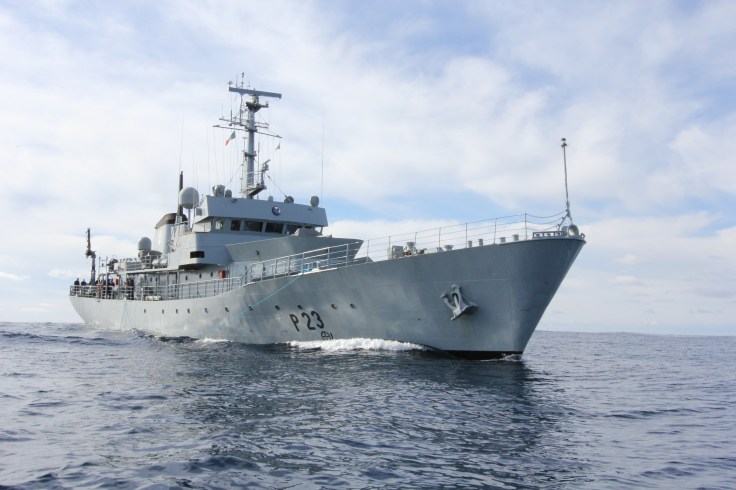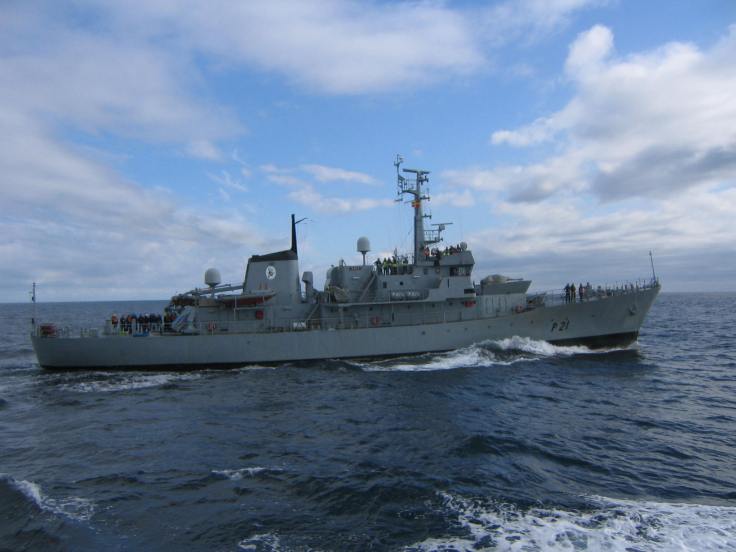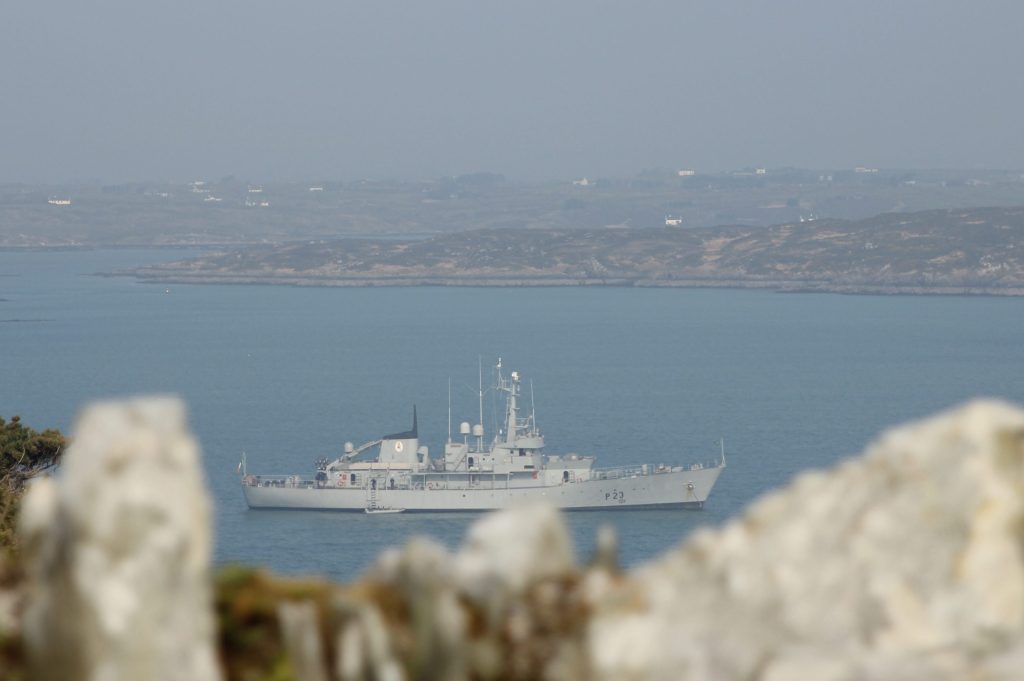Reproduced here with the kind permission of the Editor of An Cosantóir, this is my article which featured in Special Commemorative Edition on the occasion of the Naval Service 75th Anniversary.
They were the ships onboard which a generation of sailors came of age, and they lead the way for others to follow. Built in Cobh, they were designed for hard work in Irish waters, these remarkable ships delivered incredible service. The PVs occupied a special place in the heart of all who sailed on them.
The Dark Days.
In January 1970 the NS faced the new decade with only a single warship in commission, the venerable LÉ MAEV. For a number of months, which found LÉ MAEV non-operational, Ireland was left without any armed seagoing patrol vessel. It was late in 1970 when three Coniston class minesweepers were purchased. The first LÉ GRÁINNE was commissioned in January 1971, with LÉ BANBA and LÉ FOLA arriving in March. The minesweepers were capable ships, however, the need for a more suitable all-weather offshore patrol vessels was recognised. A contract with Verolme Cork Dockyard Ltd was signed in February 1971. From laying the keel in August, to its launch on 10th December 1971, the build may have only taken months, but the impact of the first homegrown warship would last for decades.
Verolme Dockyard.
LÉ DEIRDRE was 205 feet in length, and she displaced 960 tons and was the first custom-built ship for the NS. All prior commissioned warships had been purchased from the UK. Most having seen long service in the Royal Navy before they arrived to Haulbowline. To the sailors who had endured the dark days, it must have been an enormous occasion to see her launched. Modestly armed when she arrived with just a single 40mm L60 BOFORS, her internal spaces and outfitting represented a huge advancement from the corvettes. Advancements we take for granted today, but ones we never should.
Notable early operations.
In 1973 LÉ DEIRDRE joined the minesweepers LÉ FOLA and GRÁINNE in intercepting the MV Claudia. This arms interdiction operation garnered international attention. The seizure of over five tons of weapons and explosives removed any doubts that this island nation required a larger naval force. It was also in 1973, that Ireland joined the European Economic Community (EEC), which brought with it, what is today the Common Fisheries Policy (CFP). In 1975, with the fisheries limit due to be increased to 200 miles from 12 Miles, the NS was on the brink of a remarkable expansion. The Government signed a contract for a new Mark 2 DEIRDRE class PV, and began evaluating the LÉ DEIRDRE to bring improvements for the next generation. LÉ SETANTA and LÉ FERDIA joined the flotilla to assist in the extra duties required of the service. LÉ FERDIA decommissioned again 1977 and LÉ SETANTA remained in service as an auxiliary until 1984.
Between 1977 and 1980 came LÉ EMER, AOIFE and AISLING. In 1977, the then Minister of Defence Robert Molloy TD laid out a plan which envisioned eight OPVs being built, one per year, to bring the NS to 15 offshore and 10 coastal patrol vessels. Sadly, this plan was never realised, yet three Mark 2 PVs, with their increased hull length, upgraded armaments, and improved seaworthiness were here. They contributed to maintaining the core of the NS for years to come. They were to be followed in 1984 by our flagship, the helicopter patrol vessel LÉ EITHNE, the very last ship to be built in Verolme.
Fisheries Protection and Arms interdiction.
With the creation of the PV being due in no small part to European funding, it is no surprise that a day-to-day operational priority was fishery protection. Yet the primary role of the Defence Forces in to protect the state against armed aggression, so the military taskings of the NS were never far from the surface.
1984 was a most memorable year, when the two PVs LÉ Emer and LÉ Aisling carried out a significant arms interdiction operation when they seized the Marita Ann. On the night of September 29th, the trawler carrying nearly seven tonnes of arms was seized off the Kerry coast. The international intelligence operation found that the arsenal of weapons was been delivered from Gloucester, Massachusetts, supplied with connections to an organised crime gang. The huge haul included heavy machine guns, 300 rifles and over 50,000 rounds of ammunition.
Other arms shipments had made it through before, and the Marita Ann was not the last attempt. In 1987 the Eksund was intercepted by the French Customs Service of the coast of Brest. It contained a staggering 150 tons of munitions, including surface-to-air missiles and anti-tank rockets.
The four PVs and LÉ EITHNE held the line from 1987 until the purchase of the Coastal Patrol Vessels (CPVs) in November 1988.
LÉ DEIDRE.
Over half a million miles of ocean had passed under LÉ Deidre’s hull before she was decommissioned. She was the original of the species of Irish patrol vessels, and over her long career, she delivered at every turn. From MV Claudia in 1973, to arresting an entire Dutch fishing fleet of ten vessels in 1977, to saving lives in 1979 during the Fastnet Yacht race disaster, this proud warship gave her all. It was from LÉ DEIDRE that Leading Seaman Michael Quinn DSM cast off on a rescue mission in January 1990, and gave his life so that others might live.
She was sold in 2001 to a prospective conversion and retirement as a luxury yacht. After changing hands several times, this proud warship, the first of her class meet with a rather ignominious end in a breakers yard in Jacksonville, Florida. She will forever be remembered by those who served and sailed on her.
LÉ EMER.
In the course of her long service, LÉ EMER made history. She was the first NS vessel to carry out a UNIFIL resupply mission in 1979. She was there for Fastnet, and Martia Ann. She boarded fishing vessels in the thousands and made detentions in the hundreds. She was replaced by LÉ SAMUEL BECKETT, yet to those who formed her crews, she remains irreplaceable.
LÉ EMER was decommissioned and sold in 2013 to the Uniglobe Group. She still sails today as a training ship of the Nigerian navy, as due to unforeseen circumstances the Nigerian government impounded EMER on her arrival. She was commissioned and renamed as the NNS Prosperity A497.
LÉ AOIFE.
The ‘Wicked Witch of the West’ sailed out of Velrome for the first time in 1979, and it departed Verolme for last time in 2015, as P62 of the Maritime Squadron of the Armed Forces of Malta. LÉ AOIFE joined her sister PVs in a long and proud career of service of the Irish coast, and many foreign trips, including joining the annual resupply missions to UNIFIL many times. She went to the aid of HMCS Chicoutimi, a Canadian submarine which suffered a devastating fire in 2004, and she helped to coordinate the international rescue effort of British, American and Irish naval and civilian vessels which rescued the crew and towed the submarine back to Faslane on October 10. Sadly Lieutenant (RCN) Chris Saunders lost his life in this terrible incident.
She was donated to Malta to assist them in dealing with the migration crisis in the Southern Mediterranean, while they waited for their own patrol vessel to be built. Some of the sailors on service during Operations PONTUS and SOPHIA took the opportunity to visit her in her new home. A fitting end for a proud ship that had endured the worst of the wild Atlantic weather, to be able to continue her long history of service in assisting in the efforts to save lives at sea, and protect another island nation.
LÉ AISLING.
Time marches on, and LÉ Aislings decommissioning after 36 years of the most loyal service was met with the heaviest of hearts. The last of her class, she was second to none. Her crews remember their time onboard with incredible fondness, and she had carried them over 628,000 nautical miles over the years. Onboard they had faced danger, saw adventure, witnessed tragedy, and made lifelong friends. She will be long remembered as a happy ship. She was there for the Marita Ann and the sinking of the Sonia, and she held the front line during the Air India disaster. LÉ AISLING also saw the first female ships commanding officer in 2008 when Lieutenant Commander Roberta O’Brien took command.
LÉ AISLING was sold to a Dutch brokerage firm in 2017. This ageing warship, which was fully decommissioned prior to her departure from Irish waters, passed quickly through several hands and eventually, it sailed to Libya where the Libyan National Army, under Field Marshal Khalifa Haftar, renamed it as Al-Karama (Dignity). This raised the disturbing spectre of a strange reunion in the Mediterranean of serving and former Naval vessels encountering each other.
Sailing into History.
When LÉ AISLING departed it truly was the end of an era. Once decommissioned the PVs began the final voyage of sailing into history. The slips of Velrome have been silent for many years, and who knows if an Irish warship will be ever built again at home. The myths and legends will grow with each passing year, whenever old shipmates gather and spin a yarn. But from the day they left the slips in Rushbrooke, to the day they left the lower harbour, they each left an indelible mark on the Navy, and on the sailors who called them home.









Leave a comment